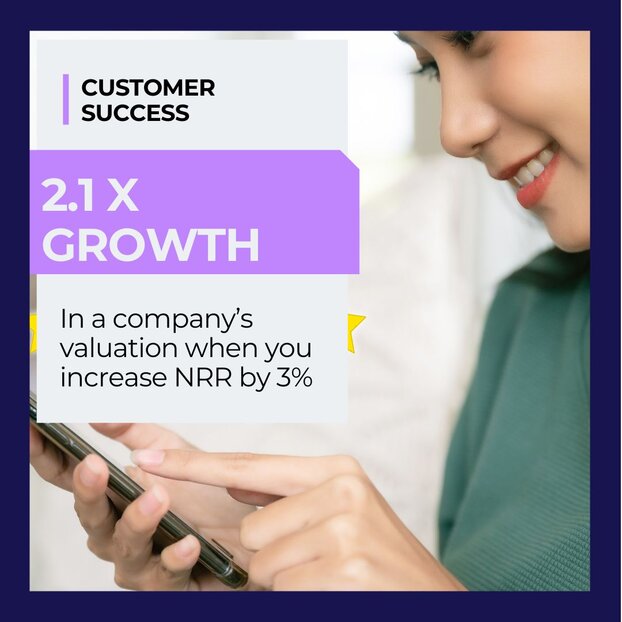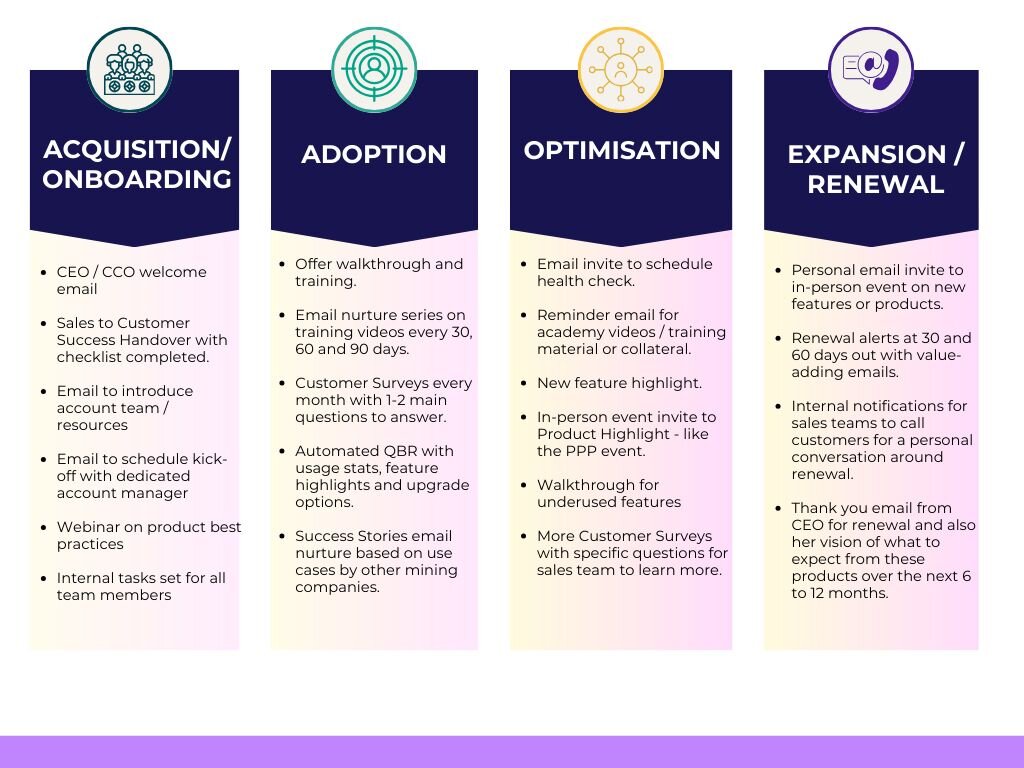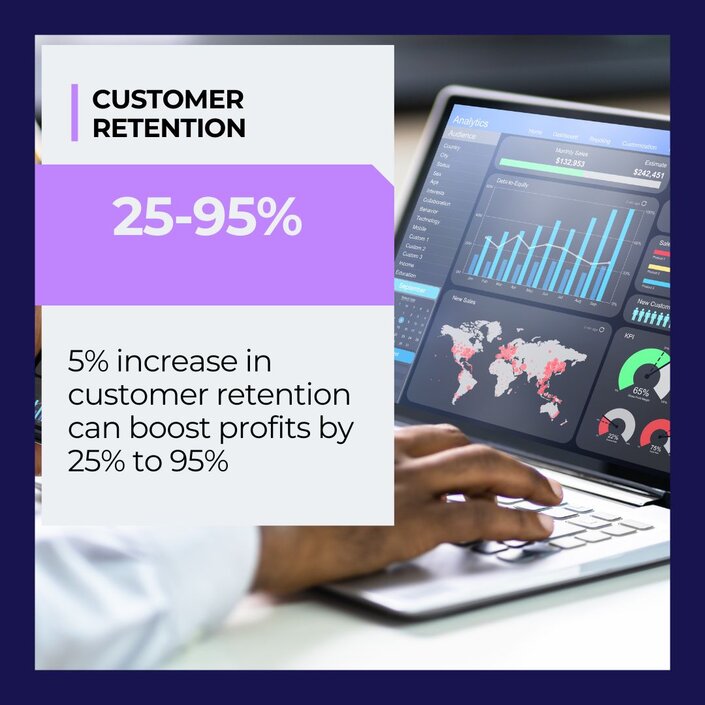Boost Net Revenue Retention
Strategies for Customer Retention
Net Revenue Retention (NRR) is the single most important metric for any B2B SaaS company looking to grow sustainably. In fact, NRR is the clearest indicator of how much a company’s revenue is growing from existing customers, considering factors like upsells, cross-sells, and churn. For businesses focused on subscription models, NRR isn’t just a number on a dashboard—it’s the lifeblood of long-term growth.
Here, we’ll break down how to boost your NRR by improving customer retention. You’ll discover actionable strategies for keeping customers engaged, ensuring they stay with your business, and increasing the revenue you generate from each client. By the end of this page, you’ll have a clear roadmap for building strong customer relationships that directly impact your bottom line.

What is Net Revenue Retention (NRR)?
Net Revenue Retention (NRR) is a metric that measures the revenue a company retains from its existing customer base over a specific period, factoring in expansion revenue (upsells, cross-sells), downgrades, and churn. A company’s NRR can either exceed 100%, meaning revenue is growing, or fall below 100%, indicating the company is losing revenue.
The formula to calculate NRR is:
NRR = (Revenue at start of period + Upsells/Cross-sells - Downgrades - Churn) / Revenue at start of period
In simple terms, NRR reflects whether your existing customers are staying and spending more or leaving and spending less.
Why Net Revenue Retention Matters
In today’s hyper-competitive B2B market, acquisition alone is not enough. A strong NRR signifies that your existing customers are not only staying with your business but are increasing their spending over time. Companies with high NRR can achieve sustainable growth without constantly relying on new customer acquisition.
Here’s why NRR is crucial:
- Lower Cost of Retention vs. Acquisition: It’s 5-25 times cheaper to retain a customer than to acquire a new one. Focusing on NRR helps reduce customer acquisition costs (CAC).
- Customer Advocacy: Retained customers are more likely to advocate for your brand, helping you grow through referrals.
- Business Valuation: Investors focus on NRR when evaluating SaaS companies. High NRR means customers find value in your product and stay for the long haul, driving predictable revenue streams.
- Upsell Opportunities: Retained customers provide opportunities for upselling and cross-selling, significantly boosting lifetime value (LTV).
Key Strategies to Boost Net Revenue Retention
To improve NRR, businesses need to focus on customer retention. Below are proven strategies that will help you keep your customers happy, boost revenue, and reduce churn.
1. Implement a Strong Customer Success Program
Customer success isn’t just about solving problems when they arise; it’s about ensuring your customers achieve their desired outcomes using your product. A robust customer success program is essential to improving NRR because it drives engagement, satisfaction, and long-term loyalty.
But there’s more to customer success than just proactive support. Automation tools can take your efforts to the next level, streamlining communication and ensuring that no customer is left behind in their journey.
Key Elements of a Customer Success Program
- Onboarding: Effective onboarding sets the foundation for customer success. Ensure customers are trained, understand how to use your product, and are aware of all its features. Automating onboarding emails, tutorials, and reminders can ensure that every customer gets the information they need without overwhelming your customer success team.
- Proactive Support: Don’t wait for customers to come to you with issues. Reach out regularly to check in, provide helpful resources, and ensure they’re getting value from your product. Marketing automation tools like HubSpot or Marketo can help by automatically scheduling follow-up emails, check-ins, and alerts based on customer activity or inactivity.
- Health Scoring: Use customer health scores to identify at-risk accounts and intervene before they churn. Metrics like product usage, login frequency, and support ticket volume can give you insights into customer engagement levels. Marketing automation platforms can alert your team when a customer’s health score drops, enabling timely intervention with tailored messaging or offers.
- Personalised Engagement: Tailor your communication to each customer’s specific goals. This could involve personalised product tips, webinars, or check-ins based on their usage data. Automation platforms can segment your customer base and trigger specific actions based on behaviours, ensuring that each customer receives highly relevant communication without requiring constant manual input.
How Marketing Automation Can Boost the Customer Pipeline
Automation tools like HubSpot, Marketo, and Salesforce allow businesses to streamline their customer success pipeline, making it easier to deliver personalised, consistent communication throughout the customer journey. Here’s how:
- Automated Touchpoints: By setting up automated workflows, you can ensure that no customer falls through the cracks. Whether it’s sending onboarding emails, product tips, or check-in messages, automation keeps the conversation going and ensures that customers stay engaged.
- Trigger-Based Messaging: Marketing automation tools can be set to trigger specific messages based on customer behaviour. For example, if a customer hasn’t logged in for 30 days, you can automatically send a re-engagement email offering assistance or additional training resources. This keeps customers involved without requiring manual follow-up from your team.
- Scalable Communication: As your business grows, manually checking in on every customer becomes impossible. Automation allows you to scale your communication efforts, ensuring that each customer receives the right message at the right time, no matter how many clients you’re working with.
- Customer Journey Mapping: Marketing automation platforms can be used to map out your customer’s journey, ensuring that they receive the right level of support at each stage. By aligning your messaging with their journey, you can proactively address concerns before they escalate, boosting satisfaction and retention.
Real-World Example:
Lihong Hicken, CEO of TheySaid, a SaaS platform that focuses on customer retention, emphasises the importance of listening to customers early. Lihong shared in an interview how engaging with customers and understanding their feedback at every stage of the journey helped them identify potential churn risks and upsell opportunities before they became critical.
By combining this proactive listening approach with marketing automation, companies like TheySaid can automate routine communications and flag critical moments in the customer journey for more personalised outreach. This not only saves time but ensures every customer is nurtured, driving long-term satisfaction and improving NRR.
Here's an example of what can be automated at each stage of the customer lifecycle:

2. Focus on Upselling and Cross-Selling
Maximising revenue from your existing customers is a key driver of high NRR. Upselling and cross-selling involve offering customers higher-tier solutions or complementary products that align with their needs.
Tips for Effective Upselling and Cross-Selling:
- Understand Your Customer’s Needs: Use data from customer interactions to identify gaps in their current setup. This could be a feature they aren’t using but could benefit from or a complementary service that enhances their experience.
- Segment Your Customers: Not every customer is an upsell or cross-sell candidate. Segment your customer base based on engagement, usage patterns, and potential fit for premium offerings.
- Provide Value, Not Just Sales Pitches: Your upsell offers should focus on delivering real value. Show customers how your higher-tier solution will solve a pain point or increase efficiency in their workflow.
- Time It Right: Timing is key. Offering an upsell too early may frustrate the customer; offering it too late means missing the opportunity. Make sure your customers are fully comfortable with your product before you propose additional solutions.
Real-World Example:
Geoff McDonald, CEO of Ambassador, discussed how his team at Ambassador built long-term relationships by focusing on well-timed upsell strategies. They didn’t push for additional services until they knew their customers had seen real results from the initial service, which built trust and made upselling easier.
3. Use Data to Drive Customer Engagement
Data-driven insights are critical to improving NRR. The more you understand about your customers’ usage patterns, preferences, and pain points, the more you can tailor your engagement to meet their needs.
How to Use Data for Customer Engagement:
- Monitor Product Usage: Track how customers are interacting with your product. This can help you identify power users, underutilised features, or areas where customers may be struggling.
- Predict Churn: Use data analytics to predict which customers are at risk of leaving. Metrics like declining product usage, increased support tickets, or longer response times can indicate churn risks.
- Customer Feedback Loops: Implement feedback loops where customers can easily share their thoughts. Use surveys, NPS scores, and one-on-one interviews to gather insights that can help you improve the customer experience.
Real-World Example:
At Zeemart, Keith Tan, Co-Founder of the B2B platform, shared how early feedback from their first few customers helped them refine their product offering and improve customer satisfaction. By listening to their customers, Zeemart built a more user-friendly product that kept clients coming back.
4. Leverage Customer-Led Growth
Customer-led growth is the idea that your customers are not just buyers but a primary source of future revenue. By turning customers into advocates, you create a cycle where they bring in referrals and new opportunities for growth.
How to Foster Customer-Led Growth:
- Referral Programs: Encourage your satisfied customers to refer their peers by offering incentives like discounts, free months of service, or exclusive features.
- Create Advocates: Happy customers are your best marketers. Highlight their success through case studies, testimonials, and social media shout-outs. By recognising their achievements, you deepen the relationship and increase loyalty.
- Engage Customers in Co-Creation: Involve customers in the development of new features or products. When they feel invested in your product’s future, they’re more likely to stick around and spread the word.
5. Reduce Customer Churn
One of the most effective ways to boost NRR is by reducing customer churn. Churn happens when customers leave your product for a competitor or decide they no longer need your services. Minimising churn should be a top priority for any business looking to improve NRR.
Tactics for Reducing Churn:
- Engage Early and Often: Frequent, proactive communication with customers helps to identify issues before they lead to churn. Keep the lines of communication open through emails, webinars, or personal outreach.
- Identify At-Risk Customers: Use health scoring and data analysis to flag customers who show signs of disengagement. Reach out to these customers with offers, personalised help, or incentives to keep them on board.
- Offer Loyalty Programs: Show appreciation for long-term customers by offering exclusive discounts, perks, or early access to new features. This can help improve retention and loyalty.
Customer Retention Strategy
Developing a strong customer retention strategy in SaaS requires careful planning and close alignment between customer success and sales teams. Here are the key elements that need to be addressed:
Onboarding Excellence
A seamless and supportive onboarding process sets the tone for long-term customer success. Providing clear guidance, training resources, and personalised support helps customers quickly realise the value of your SaaS product, increasing their likelihood of sticking with it.
Proactive Customer Support
Offering proactive support through regular check-ins and addressing potential issues before they escalate can significantly enhance customer satisfaction. Ensure your support team is well-equipped to resolve problems quickly and consistently, showing customers that their experience matters.
Usage Monitoring and Health Scores
Track customer engagement through usage data and health scores. Identify trends, monitor underutilisation, and intervene early with tailored solutions that help customers maximise your product's value and prevent churn.
Customer Feedback Loops
Regularly gather feedback through surveys, interviews, or direct communication to understand customer needs and pain points. Use this data to improve your product, services, and customer experience, ensuring you're continuously meeting their evolving needs.
Personalised Communication and Engagement
Tailor your communications and touchpoints to individual customer needs. Whether through email campaigns, webinars, or account management, delivering personalised content and outreach helps maintain relevance and fosters stronger relationships.
Upsell and Cross-Sell Opportunities
Identify opportunities to upsell or cross-sell additional features or services that align with a customer’s evolving needs. These interactions should focus on enhancing the customer's value from your platform, not just driving revenue.
Customer Education & Success Programs
Provide ongoing education to help customers fully leverage your platform's capabilities. This can include webinars, tutorials, or best practice guides, ensuring customers remain engaged and confident in using your product effectively.
Creating a clear customer success journey demonstrates that you are invested in their growth and satisfaction.
Customer retention goes beyond simply maintaining existing customers—it's about fostering long-term relationships through continuous value delivery, tailored support, and engagement.
Zig Ziglar’s quote, "You don’t build a business – you build people – and then people build the business," speaks to the essence of retention in SaaS: happy, empowered customers become advocates for your brand, fueling growth organically.
Studies have shown that a mere 5% increase in customer retention can boost profits by 25% to 95%, as loyal customers not only bring repeat revenue but are also more likely to explore upsells and cross-sells, reducing the cost of acquisition and driving sustainable growth.
Investing in retention is, therefore, one of the most strategic moves a SaaS business can make to enhance profitability and scale efficiently.
